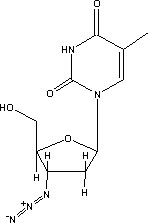Zidovudine
Zidovudine (INN) or azidothymidine (AZT) is an antiretroviral drug, the first one approved for treatment of HIV. It is also sold under the names Retrovir® and Retrovis®, and as an ingredient in Combivir® and Trizivir®. It is an analog of thymidine. more...
History
Zidovudine was the first drug approved for the treatment of AIDS and HIV infection. Jerome Horowitz first synthesized AZT in 1964, under a US National Institutes of Health (NIH) grant. It was originally intended to treat cancer, but failed to show efficacy and had an unacceptably high side effect profile. The drug then faded from view until February 1985, when Samuel Broder, Hiroaki Mitsuya, and Robert Yarchoan, three scientists in the National Cancer Institute (NCI), collaborating with scientists in Burroughs Wellcome Co., started working on it as an AIDS drug. After showing that this drug worked against HIV in the test tube, the team conducted the initial clinical trial that provided evidence that it could increase CD4 counts in AIDS patients. Like other reverse transcriptase inhibitors, AZT inhibits HIV replication by blocking the action of reverse transcriptase, the enzyme that HIV uses to replicate its RNA for splicing into the DNA of a target cell.
A placebo-controlled randomized trial of AZT was subsequently conducted by Burroughs-Wellcome (now GlaxoSmithKline), in which it was shown that it could prolong the life of patients with AIDS. Burroughs Wellcome Co. filed for a patent on AZT in 1986. The Food and Drug Administration (FDA) approved the drug (via the then-new FDA accelerated approval system) for use against HIV, AIDS, and AIDS Related Complex (ARC, a now-defunct medical term for pre-AIDS illness) on March 20, 1987, and then as a preventive treatment in 1990. It was initially administered in much higher dosages than today, typically one 400mg dose every four hours (even at night). However, the unavailability at that time of alternatives to treat AIDS affected the risk/benefit ratio, with the certain toxicity of HIV infection outweighing the risk of drug toxicity. One of AZT's side-effects includes anemia, a common complaint in early trials.
Modern treatment regimens typically use lower dosages two to three times a day in order to improve the overall quality of life. Like other antiretroviral drugs, AZT is also almost always used in highly active antiretroviral therapy (HAART). That is, it is combined with other drugs in order to prevent mutation of the HIV into an AZT-resistant form.
The crystal structure of AZT was reported by Alan Howie (Aberdeen University) in 1988. In the solid state AZT forms a hydrogen bond network. Note that AZT is based upon a sugar.
Treatment
When used as a preventative treatment, AZT has proven to be particularly effective. If treatment is started before the total amount of virus, known as the viral load, reaches a critical point of 50 million parts per millilitre of blood serum, the chance of AIDS developing is effectively zero. This is widely used with medical practitioners who receive accidental infections (please see discussion).
Read more at Wikipedia.org



